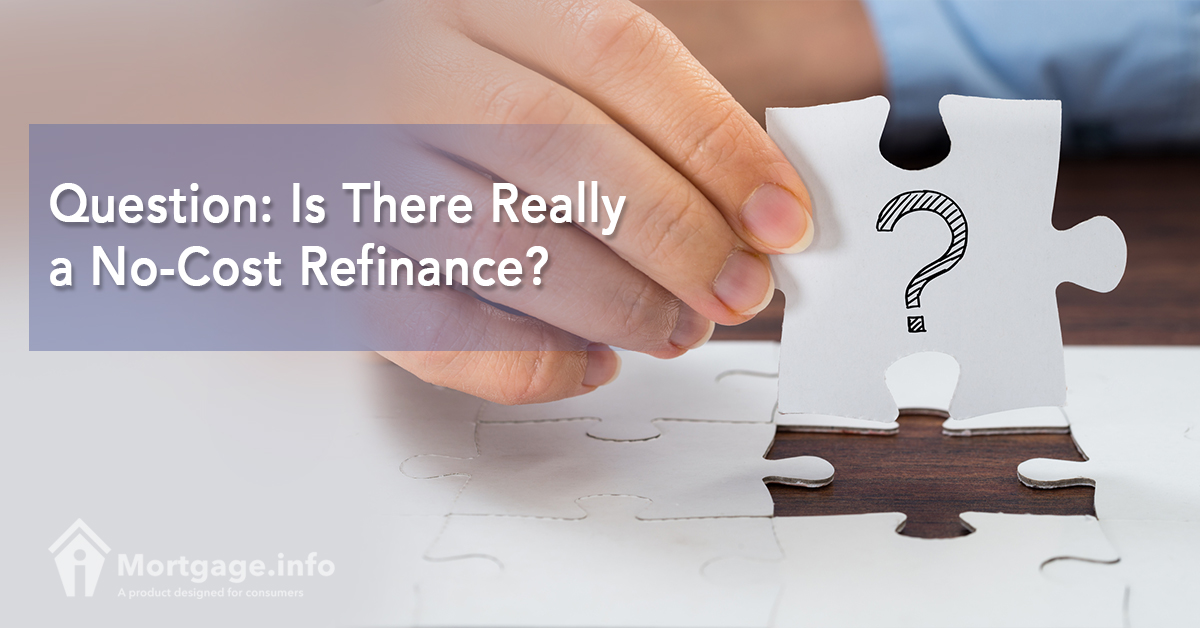
Yes, there is such a thing as a no-cost refinance. Even if you don’t shell out money for your closing costs, you can still do a mortgage refinance at no cost, at least not upfront. Your lender will foot the closing costs and you will repay the lender in the course of the loan. However, no-cost refinance has been misunderstood a few too many times that it’s best to go over its terms. »Check with our lenders what their no-cost refinance options are.»
No-Cost Refinance: Many Names, One Meaning
“No closing cost” refinance, “no-cost” refinance, “no-closing-cost” refinance, “no-cost” refinancing, “no-out-of-pocket-cost” refinancing, and “no-fee” refinance are just some terms related to no-cost refinance. But more than its many names, the term no-cost itself has been misinterpreted to mean these things:
- No lender fees.
- No costs at all.
- No out of pocket costs.
But, in reality, all mortgage refinances come with a cost, which can be 1.5% to 2.0% of your loan balance. So if you have a $200,000 mortgage loan, the expenses could reach $4,000. Closing costs are fees associated with getting a mortgage, including but not limited to:
- Loan origination fees
- Appraisal fees
- Title search fees
- Title insurance fees
- Recording fees
- Credit report fees
- And all other costs associated with processing, underwriting, and registering the new mortgage.
Closing Costs and Prepaid items
Closing costs can be paid by a lender or broker. However, there are certain fees that lenders won’t pay for. These are prepaid items, such as property taxes and homeowners’ insurance, that are related to homeownership. They have to be paid regardless of whether it’s for a new mortgage or not. At least up to 14 months’ worth of taxes and insurance premiums are required at closing.
With closing costs alone, it’s understandable why some homeowners opt for lender-paid closing costs: they can get a new, lower-rate loan without worrying about upfront costs.
»Lock in today’s low rates here.»
No-Cost Refinance: Two Types
When doing a no-cost refinance, the closing costs are repaid in two ways:
Larger Loan Balance: The closing costs are added on top of the mortgage balance. Prepaid items mentioned earlier and escrow accounts are also included in the new loan balance. Escrow accounts are usually required if: when purchasing, you put down less than 20% down payment; and when refinancing, your home equity is less than 20%.
Higher Interest Rate: The closing costs are rolled into the loan in the form of a higher interest rate, which can be a half point higher than the usual rate. This results in a lender credit, a tradeoff whereby you pay lower closing costs thus less upfront at a relatively higher rate. Given the prevailing near record low rates, the higher rates of today are still lower than they were years ago.
No-Cost Refinance: Ideal Borrowers
Generally speaking, refinancing is a great option for homeowners if:
- They have equity in their homes.
- They plan to live in the house for another three years.
- They want to lock in rates that are at least half percent lower than their current rate.
No-cost refinance, for its part, makes a good choice for borrowers:
- Who want their closing costs waived;
- Who refinance often; and
- Who will stay in the home for five years or less.
A traditional mortgage refinance could take more than five years to reach break-even, this is when you recoup the costs related to the refinance. If you don’t stick around for long, it makes little sense to fund closing costs yourself. Thus a slightly higher rate loan proves to be more cost-effective than paying closing costs in cash.
While low rates are enough reason to refinance, ask yourself what goals do you want to achieve when refinancing. If you opt for a no-cost refinancing, can you afford the new loan with a larger balance or a higher rate? Is there a way you can achieve a “no-cost” refinance in its truest sense? It’s best to seek the help of lenders when looking for answers to these questions and more.
»Find out your refinance options with the help of lenders today!»
